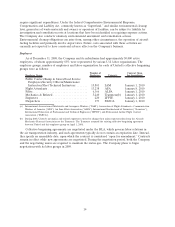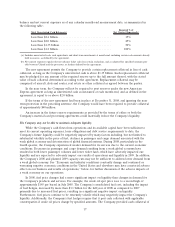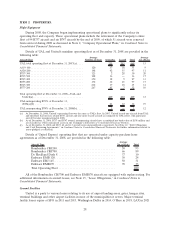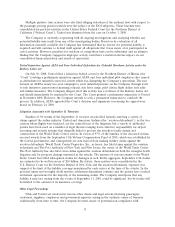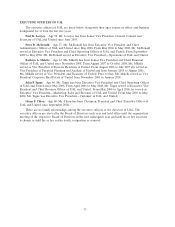United Airlines 2008 Annual Report Download - page 23
Download and view the complete annual report
Please find page 23 of the 2008 United Airlines annual report below. You can navigate through the pages in the report by either clicking on the pages listed below, or by using the keyword search tool below to find specific information within the annual report.carriers are also grounding aircraft. An impairment charge could have a material adverse effect on the
Company’s financial position and results of operations in the period of recognition.
The Company’s initiatives to improve the delivery of its products and services to its customers, reduce costs,
increase its revenues and increase shareholder value, including the operational plans recently initiated by the
Company, may not be adequate or successful.
The Company continues to identify and implement improvement programs to enhance the delivery
of its products and services to its customers, reduce its costs and increase its revenues. In response to
the unprecedented increase in fuel prices during 2008 and the weakening U.S. and global economies, the
Company began implementing certain operational plans. The Company’s efforts are focused on cost
savings in areas such as telecommunications, airport services, catering, maintenance materials, aircraft
ground handling and regional affiliates expenses, among others. In addition, the Company is significantly
reducing mainline domestic and consolidated capacity and is removing 100 aircraft from its mainline
fleet, including its entire B737 fleet of 94 aircraft and six B747 aircraft. United is also eliminating its Ted
product and reconfiguring that fleet’s 56 A320s to include United First class seats. See Item 7,
Management’s Discussion and Analysis of Financial Condition and Results of Operations for further
information regarding the Company’s capacity reductions. The Company will continue to review the
deployment of all of our aircraft in various markets and the overall composition of our fleet to ensure
that we are using our assets appropriately to provide the best available return. In connection with the
capacity reductions, the Company is further streamlining its operations and corporate functions in order
to match the size of its workforce to the size of its operations. The Company currently estimates a
reduction of approximately 9,000 positions during 2008 and 2009, through a combination of furloughs
and furlough-mitigation plans, such as early-out options. There can be no assurance that the Company’s
initiatives to reduce costs and increase revenues will be successful.
The Company is taking additional actions beyond the operational plans discussed above, including
increased cost reductions, new revenue sources and other actions. Certain of the Company’s plans to
improve its performance require the use of significant cash for such items as severance payments, lease
termination fees, conversion of Ted aircraft and facility closure costs, among others. The Company is
also reviewing strategic alternatives to maximize the value of its assets and its businesses, which may
include a possible sale of all, or part of, these assets or operations. There can be no assurance that any
transactions with respect to these assets or operations will occur, nor are there any assurances with
respect to the form or timing of any such transactions or their actual effect on shareholder value. A
number of the Company’s ongoing initiatives involve significant changes to the Company’s business that
it may be unable to implement successfully. In addition, revenue and other initiatives may not be
successful due to the competitive landscape of the industry and the reaction of our competitors to
certain of our initiatives. The adequacy and ultimate success of the Company’s programs and initiatives
to improve the delivery of its products and services to its customers, reduce its costs and increase both
its revenues and shareholder value cannot be assured.
Union disputes, employee strikes and other labor-related disruptions may adversely affect the Company’s
operations and impair its financial performance.
Approximately 83% of the employees of UAL are represented for collective bargaining purposes by
U.S. labor unions. These employees are organized into six labor groups represented by six different
unions.
Relations between air carriers and labor unions in the United States are governed by the RLA.
Under the RLA, a carrier must maintain the existing terms and conditions of employment following the
amendable date through a multi-stage and usually lengthy series of bargaining processes overseen by the
National Mediation Board (“NMB”). This process continues until either the parties have reached
agreement on a new collective bargaining agreement or the parties are released to “self-help” by the
NMB. Although in most circumstances the RLA prohibits strikes, shortly after release by the NMB,
carriers and unions are free to engage in self-help measures such as strikes and lock-outs. All six of the
23



